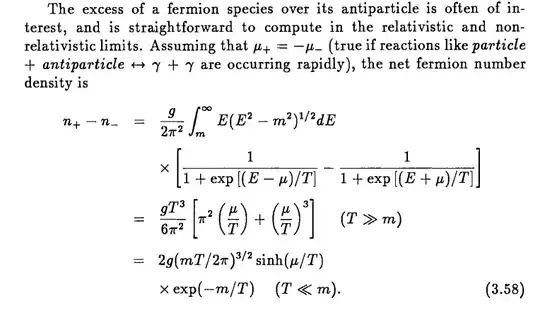If $n_+=n_-$ initially, then you are correct that thermal processes will not lead to an imbalance of particles over anti-particles (or vice versa). This passage from Kolb and Turner does not explain the matter-antimatter asymmetry, but simply relates it to thermodynamic parameters. Indeed the origin of matter-antimatter asymmetry (why $n_+ > n_-$ initially) is a mystery in cosmology.
As to interpreting the chemical potential here. The chemical potential for a photon is zero. (For example, see: Why is the chemical potential of a photon gas 0 (mathematical argument)?). Furthermore, a reaction is in equilibrium if the sum of the chemical potentials of its reactants equals the sum of chemical potentials of its products (https://en.wikipedia.org/wiki/Chemical_potential#Overview). Applying these steps to the reaction $e^+ + e^- \leftrightarrow \gamma+\gamma$ yields the relationship $\mu_+ + \mu_- = 0$. So, reversing this, the fact that $\mu_+=-\mu_-$ means the reaction is in equilibrium (just as likely to occur one way as the other), or there is no net creation or destruction of electron/positron pairs via this process.
It's important to note that as the Universe cools, the electrons/positrons will fall out of thermal equilibrium with the photon gas. Pair production becomes a rare process and so there is a net tendency for electron/positron pairs to annihilate into two photons. So, once the Universe is out of equilibrium, there is net movement of $n_+$ and $n_-$. However, the difference $n_+-n_-$ for electrons and positrons is preserved by charge conservation and lepton conservation (plus the fact that they are the lightest charged leptons).
